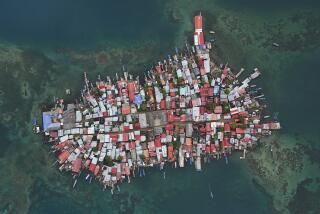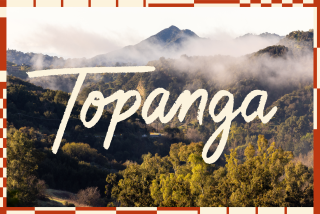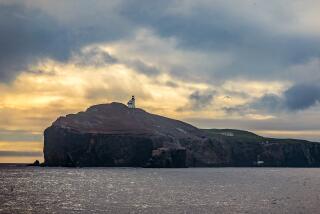Taboga, Islet of Legends
TABOGA, Panama â When Panama Citians have time to spare, they like to head for Taboga, a 2 1/2-square-mile islet in Panama Bay 12 miles from the capital. Tabogaâs Indian name means âwater mountainâ or âfish.â Romantics call it the Island of Flowers, travel brochures a tropical paradise.
But Taboga isnât a bit of heaven. People come here to get away from it all, yet âit allâ has always impinged. Therein lies Tabogaâs appeal. If you know where to look, you discover Panama in a seashell.
The only way to reach the island is by sea; it is too small and hilly for an airstrip. Passenger ferries make runs for 2 balboa (payable in $2 U.S., the countryâs paper currency). The boats leave from Pier 18 in Balboa, near the Pacific mouth of the canal. Thatâs when sightseeing begins.
From the low vantage point of a launch, canal structures look awesomely tall, and the ships too enormous to squeeze through any lock. The launch enters the Pacific under the erector-set arch of the Bridge of the Americas. Small boats bob busily, and, out farther, freighters and cruise ships queue up to enter the canal.
Ruins Among Woods
As the launch draws near the island beckons in a harmony of bright, angular walls under darker roofs, arranged against the contours of wooded hills. A squat, square tower tops the successor to what may be the oldest church in America.
Somewhere among the buildings stand ruins of conquistador villas and the overgrown pool of the wealthy cleric who in 1524 founded the Spanish village on the site of a demolished pre-Columbian one. Near the beach a heap of stones is all that remains of the house where Pizarro is said to have plotted the conquest of Peru.
Earlier still, Balboa stopped on Taboga in 1513, the year he hacked his way across the isthmus and followed an Indian trail to discover the Pacific Ocean for Europeans. In pre-canal days, ships unable to anchor near Panama City because of high tides put in at Taboga for food and water.
It is fitting that one Taboga ferry, the Islamorada, reputedly belonged to crime king Al Capone. Many earlier crime figures, notorious buccaneers of the Spanish Main, felt free to do to the542339169Incas, Mayans and other hapless indigenes.
Morganâs Treasure
They didnât always get away with it. While on Taboga to resupply, Henry Morgan and his band, who had burned and looted Old Panama in 1671, found a cache of Peruvian wine. They celebrated so heartily that they let a galleon full of gold slip away.
Some Tabogans believe that caves on neighboring El Moro contain gold hidden by Morgan. More tangible reminders of piracy are four iron crosses above a jungle trail. They mark the graves of attackers who fell in a 19th-Century raid.
The Christian monarchs of Spain sent their explorers with the cross as well as the sword. Taboga has remnants of both. Partway up the slope stands a substantial ruin, reputedly of a convent.
Fiestas celebrate two home-grown miracles. An enormous cross on the summit of Mt. Sinai is the latest replacement of several made of wood. The original was raised in thanks, they say, by a banished priest who lived off the fat of the island after he had been left here to die. Below, a beheaded bishop is said to haunt the graveyard with his head under his arm.
Traces of Past Visitors
Armies, canal builders and fishing fleets all left traces here. Heaps of colorful shells are the only remains of scallop and oyster beds harvested out of existence. Where pearl divers used to struggle to meet inhuman quotas, mother-of-pearl decorations survive on the church tower, an ornamental pond and an outdoor altar in a flower garden next to a cascading brook.
Once Taboga grew much of the capitalâs food, but only one avocado farm and some pineapple patches survive. The fruit is renowned for its sweetness.
During their ill-fated attempt to build a canal a century ago, the French, plagued by malaria and yellow fever, built an R&R; establishment here. American canal builders used it next, then a hotel/casino. Nothing is left of it, but much was recycled by American military personnel during both world wars. Discarded wood pilings now prop up the landing pier and corrugated metal huts house a factory.
Government-owned Taboga Hotel with its handsome mosaic and tamarind trees started life as a PT-boat base barracks. Its 30 air-conditioned rooms have showers. The smaller Chu Hotel is more Spartan but serves good food. Both are inexpensive and may be fully booked in North Americaâs cold season, when mainlanders claim their holiday homes and all units of the single condominium complex.
Trappings of Today
On a small scale everything is up to date on Taboga, except that cars are barred for lack of space. It hardly matters--the island can be traversed in minutes.
The hamlet boasts two streets, the Upper and the Lower, a few connecting paths, an elementary school and a government building, a shop, a disco and a plaza, statues to two prominent citizens, a food stand or two, two parks, one jail, one policeman, a Lionsâ Club.
The local Grandpa Moses, a pearl diver turned artist, peddles flamboyant primitives outside his shell-clad cottage.
Gardens are de rigeur on the Isle of Flowers, filling it with color and fragrance. Beachgoers picnic under palm frond shelters. They revel in the sun and the gentle sea, or fish lazily in waters teeming with fish.
If they steer clear of the noisy power plant and banish the thought of the bishopâs ghost, Taboga makes a no-frills Eden after all.
Visit Taboga on cruise stopovers, as part of package tours of Panama, or under cruise/flight arrangements.
More to Read
Sign up for The Wild
Weâll help you find the best places to hike, bike and run, as well as the perfect silent spots for meditation and yoga.
You may occasionally receive promotional content from the Los Angeles Times.






